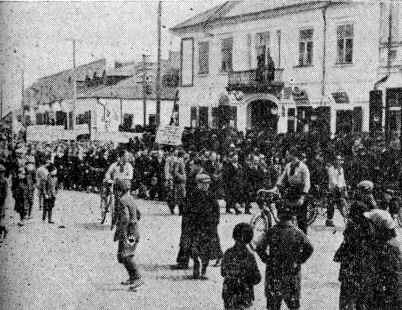 |
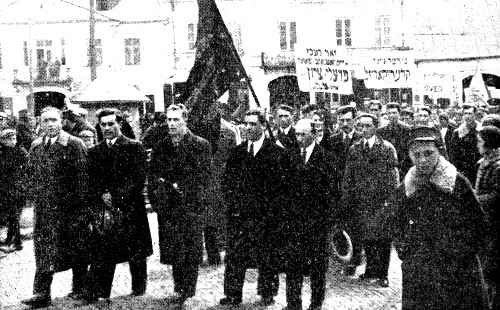 |
In the first row: Aron Brener, Motl Rop, Shimen Glozberg, Miler and Shloyme Lindenboym
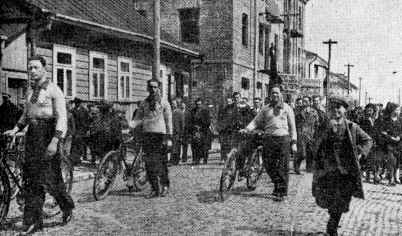 |
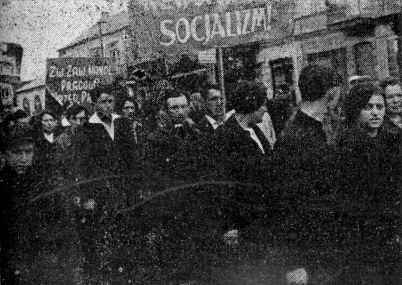 |
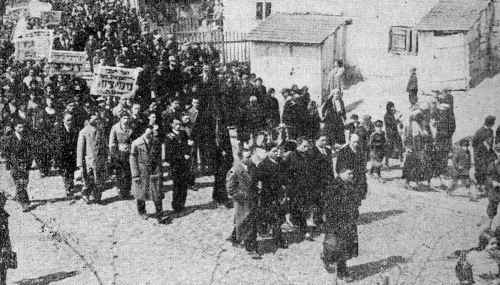 |
|
|
[Columns 185-186]
Translated by Elena Hoffenberg
Our city had the appearance of a holiday on May 1st.[1]
Workers, adorned with red flowers, filled the city from the start of the morning. As a mass they streamed to the organized May academies from the professional class unions and from the socialist Poalei-Tsiyon party (united with the Socialist Zionists), which were arranged in the city theaters.
Particularly impressive was the turnout in our academy with the participation of M. Tiger. Our comrade Yehuda Vaksman opened the academy in front of a full-packed hall and on a well-decorated stage. The choir sang the “Internationale” and during the two-hour-long lecture Comrade Tiger discussed the meaning of the First of May, the general political situation and the situation in the land of Israel.
The audience of four hundred people listened to the execution of the speech with bated breath, answering at the end of the lecture with the resounding notes of the Poalei Tsiyon Oath.
The large meeting dispatched greetings to the Socialist-Zionist comrades who languish in Soviet prisons, to the working class of the land of Israel, to the militant Chinese working class.
The Bund distinguished itself particularly well with the meeting for the First of May. It did not even deign to come when we first sent an invitation about a general May celebration. Then it answered mockingly and we decided to let the matter rest with the party, which is used to dividing the lines of the working class. The Bund indeed disappeared May 1st from the streets.
The needle-trade union almost died out. Almost no activity could be seen. The Bundist commissioner held the stamp and the needle workers suffered. The carpentry union put itself back on its feet and the earlier stamp-wielders had to stand by the side.
The action for the unemployed in the land of Israel succeeded with great effort of the comrades: we gathered around six hundred złoty.
Comrades also contributed for the benefit of the city council elections in Warsaw. We will soon have elections to the health insurance fund, to the Jewish community, and to the city council. The comrades prepare for these actions energetically.
The Celebration of May 1st, 1928
The working class of Hrubieszow prepared to celebrate the First of May this year quite impressively. Efforts were made to contribute to a common demonstration of all of the socialist parties. However, the negotiations regarding a common front failed.
Because of the fact that the regime did not permit demonstrating in the street, the May academies took place in closed halls. The local Poalei Tsiyon organized a grandiose academy in the cinema “Oaza.” There were approximately 500 people present. After the interesting speeches about the meaning of May 1st, the choir sang the Marseilles, the Internationale, and the Poalei-Tsiyon Oath.
The Bund put out a general call with the “professional class unions.” But when it came to the academy, it was a unitary front, and the Bund academy took place in its own hall. The P.P.S. [Polish Socialist Party], having received permission at the last minute, demonstrated in the street.
In the Clothing and Needle Union
Because of the disputes and bloody fights, the Clothing Central sent away a certain Feynman, so he would take care of the controversy between the “Reds” and the “Bund.” But instead of him taking care of it, he was taken care of: he was sent away with scratched hands, and a fresh bit of worker's blood was spilled as a result.
Now in an administrative manner the Central appointed a commissioner, a member of the Bund, and a mixed commission under him (of course without the “hated petsekes”)[2], for them to take over the clothing union until the general meeting. The Reds did not stand for this, signatures were collected, and they intervened all the same. How this would end, it was not known, but in the meantime the Reds had the power in their hands.
They treated our members, the needle workers, in a terrible manner. Instead of a place to work, they were sent to our party if the members did not sanction the actions of the Reds.
On the last Saturday a general meeting took place for wood workers. Additionally, idlers, flax-merchants, tombstone-carvers, and simple people, who had no connection to the work, gathered together as well. When one of our members requested to give a report, he was shut up by force. The same happened when we asked for an accounting of the money that the management had distributed to its own people.
When it came to the matter of the library, the Reds decided to register only the books that illuminate questions of the day. Our words of persuasion only lead to ignorant people taking them as their own weapon: our young member, Vertman (16 years old), beat them savagely. Not wanting to answer with the same, we left the meeting.
Recently a holiday has been celebrated on our Poalei-Tsiyon street. For our library, which consists of sixteen hundred books (Yiddish, Hebrew, and Polish), we have rented an apartment of three large halls, where open lectures will also be organized. In addition to this, we have rented a large apartment with several rooms for the party and the youth together.
[Columns 187-188]
|
|
|||
In the first row: Aron Brener, Motl Rop, Shimen Glozberg, Miler and Shloyme Lindenboym |
||||
|
||||
| Long live Poalei Tsiyon! - the slogan of the march on May 1st 1935 | ||||
|
|
|||
Translator's Footnotes:
Halman Vekerman, Tel Aviv, Israel
Translated by Elena Hoffenberg
|
|
It was in the year 1932. A group of people, members of the youth movements and the party Poalei Tsiyon, whose entire public activity was aimed at training and immigration, suddenly found themselves deprived of this possibility, and the reasons for this were twofold:
A radical turn-around occurred in those days with the possibility of immigration for artisans and experts. On the basis of this possibility, the “HeChalutz” center announced the establishment of the organization “HaOved,” whose task was to prepare artisans and professionals from the Zionist movement for immigration.
On one day, in the summer of 1932, the organization “HaOved” was established in our city.
In our private apartment, special arrangements were made to welcome those who were coming. A room was emptied of all unnecessary furniture; benches and tables were placed in it. Those who came were dressed in holiday clothes and with a happy face were excited to hear inspiring words that might change the routine of their lives.
The tables were set with everything - all the best. The meeting was opened by Shmaryahu Mints, who was sent on behalf of “HeChalutz” to help organize the “HaOved” branch in our city. He described the situation in the field of training and immigration and called on those present to study appropriate professions, those that are demanded in the land. I remember how he affected those present, and everyone signed up for the organization, while also promising to take on the yoke of the highest institutions, to do everything necessary, and to prepare themselves mentally and professionally for immigration.
For some time, the “HaOved” organization held many informational meetings and cultural activities, cooperating with the various Zionist funds and influencing the elevation of Zionist education and the unification of loosened ranks.
Unfortunately, not everyone won. The writer of these lines was among the first and the few who were privileged to immigrate in an illegal manner, after wandering, in the Second Aliyah.
And had it not been for the fear of endangering this immigration, and had it not been for the restriction that also applied to this illegal immigration, all the members of the “HaOved” organization could have been with us here.
I feel obligated to mention the names of the members who toiled and devoted their time and energy to establishing “HaOved” in Hrubieszow, but the malicious hand of the many butchers caught them. And these are the names: Motl Rop, Motl Hudis, Yosef Lederkremer, Ahron Brener and others still, whose names are remember in my heart.
May they rest in peace!
Sh. Shayntukh, Kibutz Shefayim, Israel
Translated by Elena Hoffenberg
We received permission to send 4 young people for training in Hrubieszow. I was among the happy ones.
I lived then in a town that is now in the territory of the Soviet Union. We gathered our belongings and arrived at Hrubieszow. The train station was far from the city, so we drove to the city in a carriage.
In Hrubieszow, we met comrades from Volyn, Warsaw, and Vilne. We were met with open arms. It was also the first place I saw and participated in the May 1st procession, because around us, near the border, such a procession “will not be remembered or permitted.”
For the most part, I worked as a lumberjack. With two girls I would go out in the morning: I with the ax, they with the saw and the table, which in no way could be given up.
There were families who wanted to pay us and hand over the work to the non-Jews. It once happened to me that instead of hitting a tree, I got hit in the hand. We were both young and not used to working. The woman we worked for was more frightened of me and took care of me with a shout:
- To where are these children being sent, alas.
The wound was serious and to this day a mark still remains.
Except for youth and the personalities who had been in touch with us, like Doctor Grinshpan and Hirsh Pachter, I cannot forget the ordinary Jews, the porters who sat with ropes at their sides, and the water-pumpers whose one shoulder was lower than the water-carrier.
We left Hrubieszow feeling bad. We did not want to leave, but the center demanded it of us, because the work in the grain warehouses and the flour mill was difficult. A group of thirty people, and I among them, set out for the road leading to Chelm.
After so much had happened to me, from the Ural Mountains to the illegal immigration, to Cyprus, where I spent 22 months, I am happy to note that the short time I spent in Hrubieszow is etched in my memory.
I remember one thing especially well: the youth.
|
|
Sitting from the right: Natan Hadas, Moyshe Frimer, Manchi Sokol, Ish Vesilvits, and Noyekh Gartel |
Skhora Ben-Moshe, Tel Aviv, Israel
Translated by Elena Hoffenberg
Hrubieszow was not a large city, but its youth were alert, vivacious, and mostly proletarian. Different currents operated within this youth. I would like to add to the discussion on the youth of “Frayhayt.”
Upon graduating from elementary school in 1928, I joined this organization. The work was conducted in classes named after Nakhman Sirkin, Ber Borochov, and Yosef Chaim Brener. I was a member of the Brener circle. I will not forget the comrades Meyer Hofman, Yosef Epshteyn and others, who introduced us to Zionism, the pioneer spirit, and Yiddish literature.
The branch grew day by day and in 1930-31 had more than 200 members. As a member of the branch committee, I remember very well how much toil and effort the instructions put into us, and how much energy and effort I invested in acquiring new members for our movement. We tried to attract the youth from backward houses, who were illiterate. I will not forget my friend Yosef Karlenboym-Almogi, who learned to read and write.
“Frayhayt” was the living artery in the town. It was felt at the fundraisers for the Jewish National Fund, on the day of the film for the Tel-Chai School and the like. There was no evening without action. When the youth reached adolescence, they started to pioneer and then went out for training.
Our small town had trained hundreds of pioneers and immigrants, many of whom occupy an important place in the State of Israel. There was great opposition from parents to training, however this did not frighten the instructors, who saved many youth from degeneration.
I remember that I went to training with my friend Ester Osbork (Kirshner) and her father chased us accompanied by a Polish policeman. Her parents were wealthy and claimed that they did not want their daughter to travel to Palestine to work on roads. She had a future in Hrubieszow. But we managed to dodge them and took the train. Her father turned to our comrade Hofman and threatened him if he did not find out his daughter's training place. Indeed, her aunt came to the group and forcibly brought her home.
The tragedy of her life must be sadly noted. She went through all the circles of hell in the Auschwitz camp during the Holocaust, her husband and two children perished, and she miraculously survived. At the end of the Second World War, she immigrated to the land of Israel, lonely, broken and beaten down.
A few lines about the Polish school, where I studied for 7 years. Those were the beautiful years in my childhood because I loved school and my friends. But the attitude of Polish parents towards Jewishness caused me to suffer. It is true that I did not feel it on my flesh, possibly because I was a good student, but the spirit was anti-Semitic.
There were two stationery and book stores in the town: that of the Pole Lejman and that of the Jew Vaksman. One day, when I came to school, in the hallway I saw an advertisement with letters big enough to read during the blessing of the new moon: do not buy from the Jew Vaksman, but only from the Pole Lejman.
The school was attended by several girls from ultra-Orthodox homes, who did not come to classes on the Shabbat. The literature teacher was anti-Semitic and she chose this profession precisely for the Shabbat. We did not have textbooks and she read in class. She used to interrogate the girls who did not attend on Saturdays and gave them insufficient grades. One girl asked:
– Why do I deserve such a grade? The teacher answered her:
– You are a leper Jew, go to the Jews and stand with them, and in general go to Palestine.
One day a murder happened. A Christian stabbed a Jew to death. Tensions prevailed in the town. The teacher stood up and said:
– One Jew, yid, is killed and such a fuss was made. One girl wanted to ask the teacher: what would have happened, if it had not been a Jew who was stabbed? I stopped her from asking the question out of a fear of the teacher retaliating by giving her bad grades in physics and geography.
It is difficult to describe the suffering and hardships we went through. This suffering also gave me the impetus to join a Zionist youth organization and to immigrate to the land of Israel.
Moshe Frimer, Kibbutz Ramat HaKovesh, Israel
Translated by Elena Hoffenberg
|
|
As early as 1925, a Zionist party existed in Hrubieszow, but only with the organization of “HeChalutz” did education for personal fulfillment begin for the members of Poalei Tsiyon – Ts. S. (Socialist Zionists) and “HaShomer HaTsayir.” Over time, nonpartisan youth from various circles began “to pioneer”: semi-proletarians, and also from the youth circles studying in Polish schools. The latter were not usually involved in the life of the local Jewish youth, and spoke Polish on the street. It was a great surprise for us to accept requests from young Jews studying at the Polish gymnasium in Hrubieszow to join the branch as comrades of “HeChalutz.”
In the winter of 1925-26, the “HeChalutz” branch decided to establish a training detachment for its members. The aim was a training detachment for agriculture, but we could not do that and we had to make do with contacting a Jewish sawmill owner in the village of Skrichin. The name of the Jew was Shidlovski. He had a Zionist consciousness and this was decisive in our favor, because commercially it was not worth it to him, since the non-Jews, the locals, were more talented and experienced workers than us.
We, about ten girls and boys, went out to Skrichin. The majority were boys. Our parents objected to our departure, but while the boys' parents somehow came to terms with the “disaster,” the girls' parents did not easily give up their position and used all the means at their disposal to prevent their daughters leaving for a “bad culture.”
The Jewish officials at the sawmill and the local Jewish youth received us very kindly. Immediately after we came to Skrichin, we visited the sawmill and followed the course of the work, in order to acquire an idea of the work, and not to be ridiculed in the eyes of the Christian workers. Many of us had not yet tasted the taste of work in our lives and knew about its experience by word of mouth. At first, the managers of the sawmill assigned us light work and after we succeeded in it, they transferred us to harder work, but without putting us next to the machines.
At six in the morning, the sound of a siren could be heard to wake up workers for the day's work. On Sunday, the Christian workers did not work and the sound of the siren was not heard. We worked on Sunday instead of Saturday, which we had a day off.
We devoted our free time to conversations. The topics of discussion were mainly Israel and the Hebrew language. We also set a time for recreation and entertainment. We held meetings with the Jewish youth in the village and brought them closer to Zionism.
Compared to other training places, our economic situation was satisfactory. We had a full time job and we had no deficits. On the other hand, we did not worry about saving money for immigration expenses. However, the training period did not last long, a total of about two months. Some of us received certificates, hurried back to Hrubieszow, and made all the necessary preparations for immigration. The other members did not cling to the sawmill, because in the meantime work had run out.
The number of certificates that the branch of “HeChalutz” in our city had received for its members was small. In addition, several “returnees” appeared in our city, who condemned the Land of Israel to justify their departure.
The movement “HeChalutz” in Hrubieszow was weakened. We went through difficult years, in which we were the only nucleus that attracted the yoke of the “pioneer” in our city. And it was not until the beginning of 1929 that we went out into the region and resumed the training operation. This time we went to old training places such as: Klosova, Sukhadniyav and the like. We went through a long period of training, and after much experience in hard work, we immigrated to Israel and settled there.
|
|
JewishGen, Inc. makes no representations regarding the accuracy of
the translation. The reader may wish to refer to the original material
for verification.
JewishGen is not responsible for inaccuracies or omissions in the original work and cannot rewrite or edit the text to correct inaccuracies and/or omissions.
Our mission is to produce a translation of the original work and we cannot verify the accuracy of statements or alter facts cited.
 Hrubieszów, Poland
Hrubieszów, Poland
 Yizkor Book Project
Yizkor Book Project
 JewishGen Home Page
JewishGen Home Page
Copyright © 1999-2025 by JewishGen, Inc.
Updated 17 Sep 2022 by LA